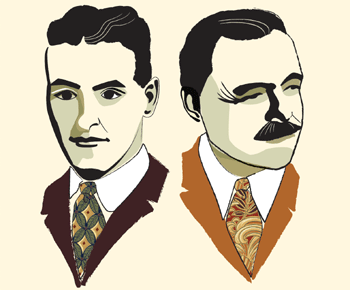Written by Kathy Gabriel December, 2009
As two of the most influential and well-known authors of the 20th century it is not surprising that F. Scott Fitzgerald and Ernest Hemingway would inspire a great many young writers. The surprise is that one of those young writers would go on to achieve a comparable level of importance to his predecessors in the literary world. Fitzgerald and Hemingway both influenced Jerome David Salinger but in very different ways.
Although J.D. Salinger never met F. Scott Fitzgerald he was still greatly inspired by Fitzgerald through his work. In his biography of Salinger In Search of J.D. Salinger, Ian Hamilton states that “the authors he most admired were Sherwood Anderson, Ring Lardner, Scott Fitzgerald: These three had almost classic status in his mind. (53). As he developed as a writer Salinger came to see himself as following in Fitzgerald’s footsteps and perhaps even achieving what Fitzgerald could not. As Hamilton reports:
In 1941 Salinger would have liked to think he was doing what Scott Fitzgerald had to do. Fitzgerald had died a year earlier, and his legendary aspects were fresh in everybody’s mind. Salinger, in his letters, always spoke warmly of him and took heart from the knowledge that it was the Saturday Evening Post that had supported the writing of the Great Gatsby. In later years he would denounce Fitzgerald’s association with the magazine. For the moment though, he believed that he—Fitzgerald’s successor—could perform a balancing act, which the master himself could never master: between the Nathan and the Woodford worlds, between integrity and commerce (64)
Aside from Fitzgerald’s overall influence on Salinger’s vision for the direction his career would take; there is also evidence that Fitzgerald’s writing directly inspired Salinger’s own works. One prominent example of this is the end of “A Perfect Day for Bananafish” which bares a striking resemblance to the end of Fitzgerald’s novelette “May Day,” published in 1920. In his hotel room Fitzgerald’s main character Gordon Sterrett took the revolver he bought at a sporting goods store and fired a shot into his own head “just behind the temple” (Fitzgerald 141). Salinger’s main character, Seymour Glass also committed suicide in a hotel room.
Ernest Hemingway’s influence on J.D Salinger and his writing was far more direct than that of Fitzgerald. Salinger first met Hemingway at the Paris Ritz in 1944. In his book Ernest Hemingway: A Life Story, Carlos Baker describes the first meeting.
Another of Ernest’s visitors at this time was a young, dark-haired sergeant in a CIC outfit. His name was Jerome D. Salinger and he was much impressed with his first sight of Hemingway. Salinger was a writer of short stories, twenty year’s Ernest’s junior. At twenty-five, he had already sold some of his work to Story magazine and the Saturday Evening Post. He found Hemingway both friendly and generous, not at all impressed by his own eminence, and “soft”—as opposed to the harness and toughness which some of his writing suggested. They go on very well and Ernest volunteered to look at some of his work. Salinger returned to his unit in a state of mild exaltation (420)
According to Hamilton “the two authors seem to have spent most of their time praising each other (86).” A later meeting was not as successful when Hemingway, a war correspondent visited Salinger’s unit. The two “got to arguing about the merits of a German Luger he was carrying as opposed to the U.S. .45, and blasted the head off a chicken to prove his point (Hamilton 86). The incident is rumored to be the inspiration for the cat-shooting scene in “For Esmé—with Love and Squalor.”
Fitzgerald and Hemingway both played vital roles in the development of Salinger’s career but their roles in each other’s lives are equally important. Hemingway was notoriously harsh regarding Fitzgerald, often insulting him in his writing. In A Moveable Feast Hemingway provides a venomous account of his first meeting with Fitzgerald in the Spring of 1925 at the Dingo Bar in Paris, despite the fact that after that meeting Hemingway took Fitzgerald’s advice on cutting the first 20 pages from The Sun Also Rises. Jeffrey Hart explores this in his article “Fitzgerald and Hemingway 1925-1926” in which he states that Hemingway also used Fitzgerald in his fiction in “The Snows of Kilimanjaro” and The Sun Also Rises, featuring Robert Cohn- a character who tries unsuccessfully to be a gentleman he is described as being “a romantic and a bad novelist” and a “sloppy drunk.” All thought to be jabs at Fitzgerald.
Despite Hemingway and Fitzgerald’s tumultuous relationship both were successful in making an impact on J.D. Salinger. It seems that he used them both for inspiration directly in his writing and used their careers as guides in finding his own path.
Works Cited
Baker, Carlos. Ernest Hemingway: A Life Story. New York: Scribner’s, 1969. Print.
Hamilton, Ian. In Search of J. D. Salinger. New York: Random House, 1988. Print.
Hemingway, Ernest. A Moveable Feast. New York: Scribner’s, 1996. Print.
Salinger, J. D. Nine Stories. New York: Back Bay Books, 2001. Print.
Skow, John. “Sonny: An Introduction.” Time 15 Sept. 1961. Print.


Yes! Finally someone writes about todays.
Where did you get the tip on the similarity between “A Perfect Day for Bananafish” and “May Day”? I’ve been searching the source for ages. Please let me know. Thank you!